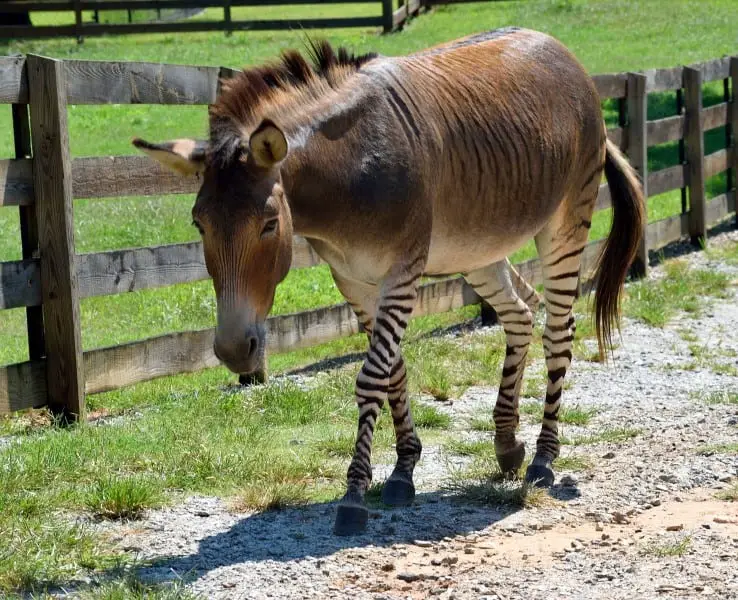Are you looking for an answer to the question do animals cross breed in the wild? Well, in this article we’re going to provide the definitive answer and other details. But first, here’s the quick answer, then we’ll dive into more details…
Do Animals Cross Breed in the wild? Yes, animals cross breed in the wild. Overlapping territories, the Results of Climate Change, and fewer available mates are the main reasons why animals cross breed in the wild.
In fact, the golden-crowned manakin is the first known cross breed reported in the Amazon. This is a cross between opal-crowned manakin and snow-capped manakin.
So now we know the quick answer, here’s a bit more detail around why, when, and why!
People usually know of one example of cross-breeding, whether it’s animals like Mule, Liger, Zebroid, or others. These all sound unusual because it’s often a combination of two animals. In short, this means it’s a hybrid or cross between two different animal species.
It’s intriguing how these animals have features similar to the two animals they were produced from (the animals that crossbred).
However, some of these are contrived and crossbred in captivity, so the question is do animals crossbreed in the wild?
Or are they just forced to crossbreed to make zoo cages more interesting with fascinating animals?

Do Animals Cross Breed in the wild?
The first incident – or occurrence – of a cross-breed is in the amazon forest and can provide some understanding of how cross-breeding works.
It started with two green birds named the snow-capped manakin and the opal-crowned manakin.
Both of these birds look very similar. The opal-crowned manakin has feathers that can often look blue, white, or even red – depending on the light. Whereas the snow-capped Anakin has white feathers.
A crossbreed occurred between the two bird species, (opal-crowned manakin and snow-capped manakin) which created the now known golden-crowned manakin, which has yellow feathers.
This is the first-ever known crossbreed that’s been evidenced to have happened in the Amazon.
However, when this cross-breed created the golden-crowned manakin, its feathers looked more like whitish-grey.
But in the later generation, they grew yellow feathers …and so earning the name golden-crowned manakin.
This bright yellow color helped males to appear more attractive to females. So golden-crowned manakin females preferred mating with their golden-crowned males rather than mating with or cross-breeding with snow-capped or opal-crowned males.
This eventually led to these birds being separated, by crossbreeding continuously among themselves.
This means that these golden-crowned manakins became separate from their original species …and became their own distinct species – the golden-crowned manakin.
Generally speaking, different species do not mate – or crossbreed, but when they do, their offspring are therefore called “Hybrids”.
So now we have a good example, let’s look at why and when animals crossbreed in the wild.
Why and when do animals cross breed in the wild?
There are many reasons why cross breed occurs in the wild. Below are a few of the most common reasons for cross-breeding in the wild.
Overlapping territories
This is where the territory of two similar animals can overlap. This has happened with both polar bears and grizzly bears, which produced the grizzly-polar bear hybrid.
This is a crossbreed that has in fact occurred both in the wild …as well as in captivity. This crossbreed and hybrid were confirmed in 2006.
Climate Change
It’s common for many animals to change their habitats, change behavior, or alter their migration patterns when faced with climate change.
As such when animals move to new places and new habitats, they may come more closely into contact with similar species.
So as you might expect, these two different species may be inclined to mate, producing hybrids.
One such incident is the hybrid of southern and northern flying squirrels. The southern squirrels moved further to the north when the climate became warmer and mated with the northern squirrels, thus producing hybrids.
Fewer mates
There are instances where certain species may not find enough mates from their own species.
Especially with many animals becoming extinct, finding mates from their own species may be a difficult task. When there’s a shortage of mates, animals will naturally look to the next best option.
So, when animals find very few mates of their own species to mate, they may crossbreed in the wild.
This has indeed happened with two antelope species. When the population of giant stable and roan antelopes thinned out, these two species crossbreed in the wild, producing hybrids.
Captivity
Of course, other than the circumstances mentioned where animals crossbreed in the wild, it’s also the case that people purposely create opportunities for cross breeding in captivity.
Most often this is done by simply putting two closely related species in the same cage or enclosure.
Habitat changes
As cities continue to expand, both rural and urban animals can be pushed closer together which can lead to mating.
People even allow animals from other countries to enter new habitats in different countries in order to create cross-breeding and new hybrids.
So, let’s look at whether cross-breeding in the wild is good or bad!
Is cross-breeding in the wild good or bad?
In general, many hybrids produced as a result of cross-breeding in the wild – or even in captivity are sterile.
This means that hybrid animals that come into existence because of crossbreeds cannot produce their own offspring.
For example, a cross between a donkey and a horse is a mule. But two mules cannot cross and produce more mules because they are sterile.
But, a donkey and a horse can crossbreed and produce more mules. So because of this many believed that the two parents would merge into one and would eventually reduce the variation in the species.
This is one of the reasons why hybridization was viewed as a bad idea.
But the good side is that cross-breeding in the wild can boost diversity. This is because a hybrid can sometimes eat or live in places where its parent species were not able to.
So even if the parent species becomes extinct, these hybrids could ensure their species survive – and indeed thrive – just like the golden-crowned manakin.
The reason why this might be the case is that because hybrids have a mix of DNA, they have more variation in the DNA they inherit, offering them different and potentially better survival traits than their parents.
Do animals cross breed – To finish…
We hope this has been useful in answering the question do animals crossbreed in the wild.
This content has been checked and verified by a qualified veterinary practitioner. The article has been reviewed by our editorial board and has been approved for publication in accordance with our editorial policy.
